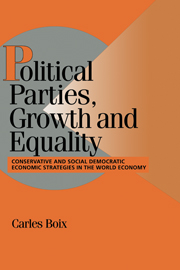 Political Parties, Growth and Equality
Political Parties, Growth and Equality Published online by Cambridge University Press: 05 June 2012
In Chapter 1 I emphasized that, contrary to the findings of the current theoretical literature and contrary, as well, to popular wisdom, political parties, understood as coalitions of interests and ideas, play a rather pivotal role in the economic-policymaking process and in the evolution of the economy. More precisely, I pointed out that, although they are constrained by the configuration of domestic institutions and the international economy in regard to macroeconomic policymaking, all governments have substantial autonomy to affect the production factors or structural conditions of the economy in line with their ultimate partisan preferences. Broadly speaking, social democratic governments primarily mobilize the public sector to shape the supply side of the economy – in order to reconcile growth and equality. Conservative governments believe instead in employing market mechanisms to optimize the savings and investment rates and thus maximize economic growth.
To shed light on the nature and consequences of these economic strategies, and to pave the way for the statistical and historical analysis undertaken in the rest of the book, this chapter starts by developing a stylized model of the political economy of advanced nations. The second section then provides empirical evidence on the economic trade-offs revealed by this model (essentially between unemployment and economic inequality), that all advanced countries face. The third section examines the alternative economic strategies that different parties will embrace, depending on their initial preferences (presented in Chapter 1) toward the distribution of income, to manage the supply side of the economy.
To save this book to your Kindle, first ensure [email protected] is added to your Approved Personal Document E-mail List under your Personal Document Settings on the Manage Your Content and Devices page of your Amazon account. Then enter the ‘name’ part of your Kindle email address below. Find out more about saving to your Kindle.
Note you can select to save to either the @free.kindle.com or @kindle.com variations. ‘@free.kindle.com’ emails are free but can only be saved to your device when it is connected to wi-fi. ‘@kindle.com’ emails can be delivered even when you are not connected to wi-fi, but note that service fees apply.
Find out more about the Kindle Personal Document Service.
To save content items to your account, please confirm that you agree to abide by our usage policies. If this is the first time you use this feature, you will be asked to authorise Cambridge Core to connect with your account. Find out more about saving content to Dropbox.
To save content items to your account, please confirm that you agree to abide by our usage policies. If this is the first time you use this feature, you will be asked to authorise Cambridge Core to connect with your account. Find out more about saving content to Google Drive.